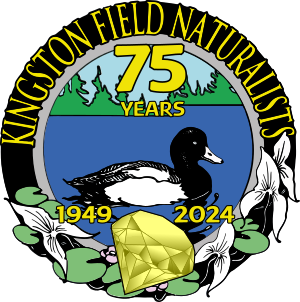by Sharon David
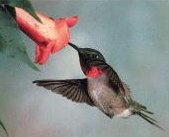
Introduction
In this part of Wildlife In My Backyard I will describe various gardens and flowers needed to attract hummingbirds and butterflies to your backyard during the upcoming summer months. Gardening for hummingbirds and/or butterflies need not be on a large scale, but could be obtainable on a balcony or in a small backyard. If you have an existing garden you most likely have some plants they use, but you could probably add a few specific plants.
Hummingbirds
The hummingbird is one of the most favourite of our summer garden visitors, and is often mistaken for a bumblebee if not closely examined. Flower gardening for hummingbirds is often easier than providing feeders. This is due to the sugar water in the feeders needing daily to semi-daily changes during the warm summer months, as the sugar ferments in the heat and could potentially cause salmonella poisoning and kill the hummingbirds. For those of you who cannot be dedicated to the frequent feeding solution changes should provide flowers which will be a safer alternative.
In the Kingston area, and all of North America east of the Mississippi River, there is generally only one hummingbird found — the Ruby-throated Hummingbird. The average spring arrival date for Kingston is May 9, and fall departure usually underway in August with most gone by September 21.1
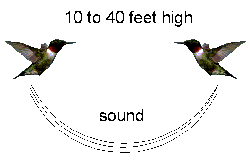
Male Ruby-throats arrive ahead of females in the spring and establish territories around nectar rich flowers. The dive display, accompanied by a loud buzz, of the male will often alert you that a nearby female is being courted.2,3
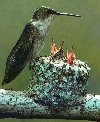
The female builds a 1½” nest of plant down, lichens or bud scales, usually 10 to 20 feet above ground in coniferous or deciduous trees. Incubation of 2 eggs lasts about 16 days, and the nestling period is from 14 to 31 days.2,3
Some interesting facts about hummingbirds: Ruby-throats weigh 3 grams; the hummingbird egg is half the size of a jellybean; the wing beats 78 times per second during regular flight and 200 times per second during the male display dive; a resting hummingbird takes 250 breaths per minute; Ruby-throats fly 500 miles nonstop across the Gulf of Mexico to their overwintering grounds. Some fiction: Hummingbirds eat only nectar (no, they also spend time catching insects like small spiders); Hummingbirds feed only at red flowers (no, they visit flowers of all shapes, colours and sizes, but have learnt that trumpet shaped and red flowers often have more nectar); Hummingbirds migrate on the backs of Canada Geese (this is a very widespread and popular myth but there has been no scientifically documented evidence).2
Using Feeders to Attract Hummingbirds
Using feeders to attract Hummingbirds is sometimes simpler than planting flowers, but you will not be able to keep hummingbirds around if there are no natural food sources in your area. Hummingbirds require not only nectar but also protein and they obtain that from bugs like spiders that occur on natural nectar producing flowers, or by gleaning them from the undersides of leaves or on buildings.
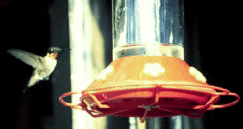
You can provide feeders to supplement your flower plantings and provide you with a closer view of the hummingbirds. However, the responsibility of providing sugar water in these feeders is high, and if you cannot be dedicated to the required weekly and sometimes bi-weekly solution changes, you should just plant flowers or place a hanging basket to watch the hummingbirds close to your window instead. The reason for this is that sugar water can ferment and grow bacteria during the warmer months, and by being placed in direct sunlight. When temperatures are below 70 F (20 C) you should change the feeder solution on a weekly basis. When temperatures are above 80 F (30 C) or your feeder is in direct sunlight above 70 F you should change it from 3-4 day intervals. If you do not change your solution the birds can become sick from the bacteria, contract salmonella and die. Do not fill your feeder full of sugar water but only an amount that the birds would drink in 4 days which will also be your cue to change the feeder, and also save on the sugar water.
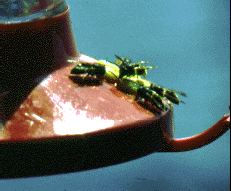
There are many types of hummingbird feeders on the market, both glass and plastic as well as different styles. There are several things to consider when purchasing a hummingbird feeder, but in particular will be the location of placement. If you place the feeder in direct sunlight for most of the day a plastic one is not recommended as the plastic will discolor. If you place your feeder in a windy location you should buy a feeder that has the feeding ports on top of the feeder and not on the sides, as this will help prevent the sugar water from leaking out as it rocks back and forth in the wind and attracting wasps. If you want to purchase a window suction cup feeder you have to remember that you will probably have sugar water getting on the window if your feeder is in direct sunlight, creating a messy situation, and you will possibly have ants climbing up the window to the feeder. Place a window suction cup feeder on the shady side of the house to decrease this, or instead of a window suction cup you can purchase a hanger bracket and hang a regular hanging feeder. One nice thing that a hummingbird feeder does provide is easy viewing of the hummers and also allows you to start feeding them early in the season, like in May, when they just return, but when no flowering plants are available as a natural food source. I also will place out a hanging basket of fuschia in early spring and bring it indoors at night so that the birds are also attracted by the flowers.
Designing a Hummingbird Garden
Designing a hummingbird garden in connection with an existing garden is much easier than starting from scratch but both require similar designs. Hummingbirds require narrower gardens than butterflies in order to access flowers on either side. Curving flower beds and clusters of trees and shrubs are better suited to the needs of hummingbirds so they can approach the blooms from all sides. The garden should not be crowded with large trees and shrubs. A good balance is ¼ shade, ¼ partial shade, ½ open area of lawn, ground cover, or flower beds (Figure 2). Create a variety of levels with tall trees, medium-height trees, shrubs, flowers and low grassy areas. These different areas will give your hummingbirds choices of where to feed and perch.3 Male hummingbirds prefer to have one large tree to use as a strategic lookout post.3
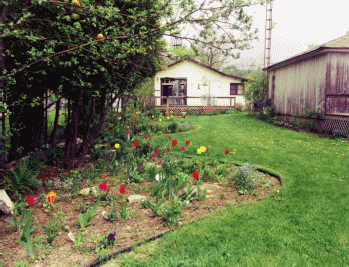
A. Container Plants
Containers offer plantings in a limited space such as on a balcony, and can also offer nectar sources in early spring before garden plants bloom. Containers such as baskets, pots, window boxes, and planters are kept indoors during cold weather, and on warm days are placed in open areas where hummingbirds can find them. Feeders can be placed out as a supplemental food source. Fuschias are a favourite hummingbird plant and perfect for containers. Other good choices include annual phlox, basket begonia, nasturtium, petunia, scarlet sage, and snapweed.3Place your hibiscus outdoors during the spring and summer as well.
B. Wildflowers
Wildflowers often offer more nectar than the cultivars that have been derived from them and are an excellent choice for natural settings (Table 1).3 Please do not go digging up wildflowers to transplant to your garden. Many wildflowers can be purchased from seed catalogues, or by purchasing wildflower seed mixtures at most nurseries. If you cannot find that particular plant you want for your garden, mark the wildflowers’ location and return when the plant has gone to seed and collect some of the seeds for your garden.
Table 1: Hummingbird Wildflowers of the East
| Begonia Family Cross Vine, Bignonia capreolata Trumpet Vine, Campsis radicans | Mint Family Bee Balm, Monarda didyma Purple Bergamot, Monarda media |
| Bluebell Family Cardinal Flower, Lobelia cardinalis | Morning Glory Family Red Morning Glory, Ipomoea coccinea |
| Buttercup Family Wild Columbine, Aquilegia canadense | Phlox Family Texas Plume, Ipomopsis rubra Smooth Phlox, Phlox laberrima Wild Sweet William, Phlox maculata |
| Evening Primrose Family Fireweed, Epilubium angustifolium | Logania Family Indian Pink, Spigelia marilandica |
| Honeysuckle Family Trumpet Honeysuckle, Lonicera sempirvirens | Pink Family Fire Pink, Silene virginica Scarlet Lychnis,Lychnis chalcedonica |
| Iris Family Red Iris, Iris fulva | Snapdragon Family Indian Paintbrush, Castilleja coccinea Red Turtlehead, Chelone oblique |
| Lily Family Canada Lily, Lilium canadense Wood Lily, Lilium philadelphicum | Touch-Me-Not Family Pale Jewelweed,Impatiens pallida Spotted Jewelweed, Impatiens capensis |
C. Annuals, Perennials, Vines, Trees, and Shrubs
Planting perennials in a new garden can be very expensive and may take several years for maturation to their full potential so annuals are a convenient substitute, or filler. Among my flower favourites are bleeding heart, bee balm, columbine, coral-bells, lupine, nasturtium and verbena.
Numerous trees, shrubs and vines also attract hummingbirds. Some favourites include butterfly bush (no garden should be without!), hibiscus, flowering crab apple and honeysuckle. Of the vines morning glory and in particular trumpet honeysuckle are a garden must. Table 2 summarizes hummingbird plants that are available at most nurseries, or from mail-order garden catalogues, such as Stokes.
Table 2: Hummingbird plants available at nurseries.3
| Herbacious Plants | |
| Bee Balm, Monarda spp. | Begonia, Begonia spp. |
| Blazing Star, Liatris spp. | * Bleeding Heart, Dicentra spp. |
| * Butterfly-Weed, Asclepias tuberosa | Canna, Canna generalis |
| * Cardinal Flower, Lobelia cardinalis | Carpet Bugle, Ajuga reptans |
| Century Plant, Agave americana | * Columbine, Aquilegia ssp. |
| * Coral-Bells, Heuchera sanguinea | Dahlia, Dahlia merckii |
| Dame’s Rocket, Hesperis matronalis | Delphinium, Delphineum spp. |
| Fire Pink, Silene virginica | * Flowering Tobacco, Nicotiana alata |
| * Four-o’-Clock, Mirabilis jalapa | Foxglove, Digitalis spp. |
| * Fushsias, Fuchsia spp. | Geranium, Pelargonium spp. |
| Gilia, Gilia ssp. | Gladiolus, Gladiolus spp. |
| Hollyhocks, Althea spp. | * Impatiens, Impatiens spp. |
| * Lantana, Lantana camara | * Lily, Lilium spp. |
| * Lupine, Lipinus spp. | * Nasturtium, Tropaeolum majus |
| Paintbrush, Castilleja spp. | Penstemon, Penstemon spp. |
| Petunia, Petunia spp. | * Phlox, Phlox spp. |
| Red-Hot Poker, Kniphofia uvaria | Scabiosas, Scabiosa spp. |
| * Scarlet Sage, Salvia splendens | Spider Flower, Cleome spinosa |
| * Sweet William, Dianthus barbatus | * Verbena, Verbena spp. |
| Yucca, Yucca spp. | * Zinnia, Zinnia spp. |
| Shrubs | |
| Abelia, Abelia grandiflora | Azaleas, Rhododendron spp. |
| Bearberry, Arctostaphylos spp. | Beloperone, Beloperone californica |
| Beauty Bush, Kolwitzia amabilis | * Butterfly Bush, Buddleia davidii |
| Cape Honeysuckle, Tecomaria capensis | * Currant, Ribes odoratum |
| Flowering Quince, Chaenomeles japonica | Gooseberry, Ribes speciosum |
| Hardy Fuschia, Fuschia magellanica | * Honeysuckle, Lonicera spp. |
| Hibiscus, Hibiscus ssp. | Jasmine, Jasminum ssp. |
| Scarlet Bush, Hamelia erecta | * Weigela, Weigela spp. |
| Vines | |
| Cypress-Vine, Quamoclit spp. | * Honeysuckle, Lonicera spp. |
| * Morning Glory, Ipomea ssp. | Scarlet Runner-Bean, Phaseolus coccineus |
| Trumpet Creeper, Campsis radicans | * Trumpet Honeysuckle, Lonicera sempervirens |
| Trees | |
| Chaste-Tree, Vitex agnus-castus | Chinaberry, Melia azedarach |
| Cockspur Coralbean, Erythrina cristi-galli | Eucalyptus, Eucalyptus spp. |
| * Flowering Crab, Malus spp. | Hawthorn, Crataegus spp. |
| Horse Chestnut, Aesculus glabra | Locust, Robinia spp. |
| Orange Tree, Citrus spp. | Palo Verde, Cercidium microphyllum |
| Poinciana, Caesalpinia spp. | Red Buckeye, Aesculus carnea |
| Royal Poinciana, Delonix regia | Siberian Pea Tree, Caragana arborescens |
| Silk Oak, Grevillea robusta | Silk Tree, Albizzia julibrissin |
| Tree Tobacco, Nicotiana glauca | Tulip Poplar, Liriodendron tulipfera |
References
- Weir, R.D. 1989. Birds of the Kingston Region. Kingston: Quarry Press Inc. 608pp.
- Stokes, D. and L. Stokes. 1989. The Hummingbird Book. Boston: Little, Brown and Company. 89pp.
- Arbuckle, N. and C. Crocker (eds.). 1991. How to Attract Hummingbirds and Butterflies. California: Ortho Books. 112 pp.
